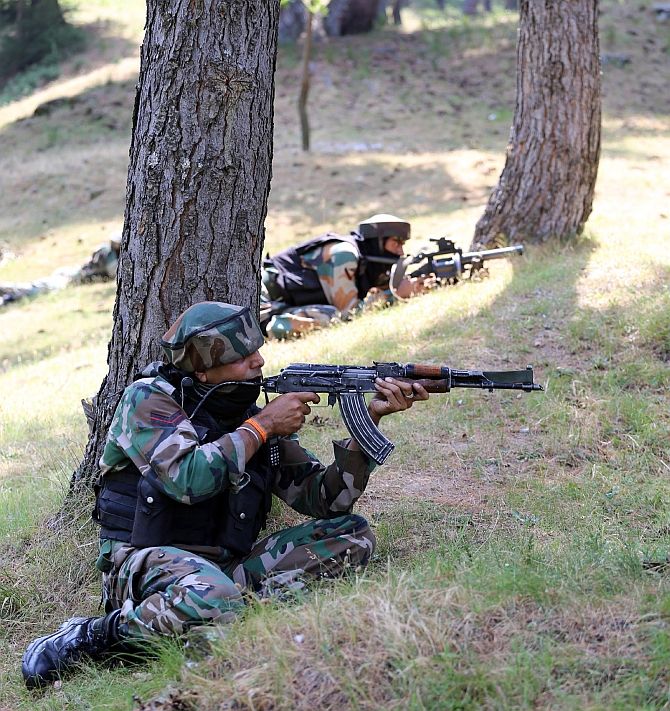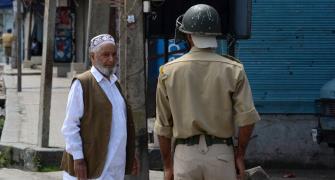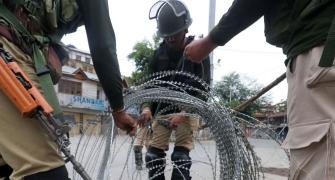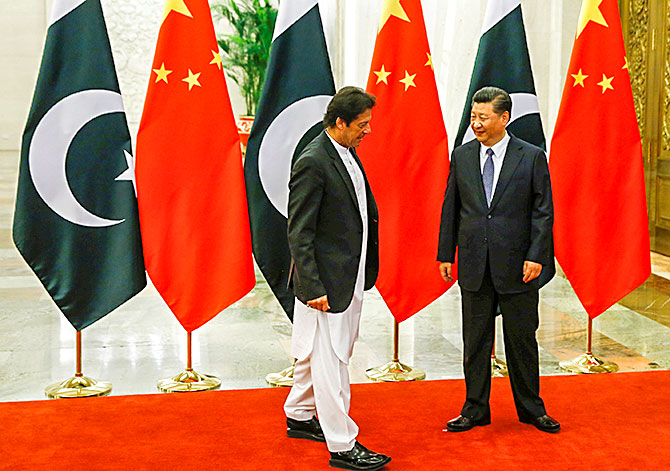'If the strength of foreign terrorists can be brought to negligible levels there will be few takers for militancy.'
'That is why it is important to neutralise the terrorists at their launch pads,' advises Lieutenant General Syed Ata Hasnain (retd).

Since early August 2019 the Line of Control has witnessed sporadic exchanges of firing between the Indian and Pakistan armies. It is being quoted that approximately 2,000 cease fire violations have occurred from the Pakistan side through 2019.
The intensity of exchanges did not raise too many eyebrows thus far. However, the recent nature of these and related events are now drawing more attention. On October 19, Pakistan reportedly used anti-tank guided missiles to target some Indian Army forward posts in the Tangdhar sector causing two fatal casualties.
The Indian Army retaliated in higher measure targeting at least four well known terrorist camps in the vicinity of the LoC which also act as launch pads and Pakistan army positions employing mortars and medium artillery.
The Indian Army chief has himself confirmed that 8 to 10 Pakistan army personnel and an indefinite number of terrorists were killed.
So what's new about these events? Is there any significance relating to the ongoing tension between India and Pakistan which got intensified after the government's decision to abrogate Articles 370 and 35A on August 5 this year?
Pakistan has been raving and ranting about the decision which India hopes will help fully integrate Jammu and Kashmir more firmly into the Indian Union and strengthen its claims over territories still in occupation by Pakistan -- that is Pakistan occupied Kashmir, to include Gilgit and Baltistan.
In relation to these events the departure from the known normal at the cusp of winter, is that both firing and infiltration are taking place in the area of the Kashmir segment of the LoC.
The usual practice, at least in the last 10 to 15 years, has been that infiltration attempts are mostly in the Kashmir segment north of the Pir Panjal range and exchange of fire involving CFVs is witnessed in the Jammu segment south of the Pir Panjal.
It has been reported that continuous infiltration attempts have been made by terrorists supported by their Pakistani sponsors in Kashmir since the end of July.
The J&K police has confirmed that 45 to 60 terrorists could have successfully infiltrated in a short period by mid September.
Since early October, the Rashtriya Rifles and Parachute Special Forces have been combing the heights above the Ganderbal-Kangan segment of the National Highway leading from Srinagar to Leh.
The Harmukh-Gangabal area lies between the high altitude tehsil of Gurez and the NH in the Kangan area. 15 to 20 Pakistani terrorists are believed to be hiding in this area avoiding contact with the army. Two to three terrorists have been killed in initial contact with army patrols at Gangabal.
That Pakistani terrorists used the difficult Gurez route to infiltrate, after a period of almost ten years, appears to reveal the level of desperation to induct terrorists into Kashmir's hinterland.
Without adequate strength and leadership, the violent movement sponsored by Pakistan is unlikely to sustain, especially after the inability of the separatists and the terror groups to enhance the levels of violence post the decisions of August 5.
45 to 60 terrorists successfully infiltrating into Kashmir has in recent years been considered as just about adequate strength to add to the fresh local recruitment in south Kashmir. This usually partially makes up for the loss of foreign terrorists suffered at the hands of the Indian Army.
However, this year there is another phenomenon to take care of. There has hardly been any local recruitment. Just 47 new recruits had been added to the existing strength by June and many of them have already been neutralised.
With additional armed police deployed due to the landmark decisions and the subsequent 'lockdown', the ability to recruit and add strength has been diluted even further. Hence, the desperation being witnessed at the LoC and the willingness on the part of terrorists to use difficult terrain such as Gurez for infiltration.
The infiltration effort has been all along the LoC from Uri to Keran and probably extending to the northern gullies in Machil and beyond to Gurez. Yet, the prime area seems to be Lipa to Keran from which routes all converge at Handwara and then to Baramulla and Sopore.
If successful, it will assist in reviving militancy in the north Kashmir districts of Kupwara, Bandipur and Baramulla.
The Indian Army knows this very well and also that counter infiltration isn't the easiest of operations. The LoC fence is a good obstacle, but its stopping power has eroded substantially over time.
Thus, the decisions to target launch pads which usually house 10 to 30 terrorists is a sound one, provided you have adequate intelligence.
There is no need to await them at the LoC itself and give them a chance to escape inwards, given the very difficult terrain that exists.
In the last few days we have targeted the notorious launch pads cum camps at Lipa, Jura, Athmuqam and Kundalshahi, the latter three being in the Nilam valley. These camps are just a set of a few houses close to villages in Pakistan occupied Kashmir or within the village itself.
Surprise is an important factor otherwise with the first salvo of artillery fire the terrorists get a chance to disperse and hardly offer a target.
The chances of civilian casualties are high and Pakistan will use this phenomenon to paint India red with some guided tours of foreign media and briefings to defence attaches.
While the Nilam sub sector is an area where our domination abounds infiltration has been a major issue here. We need to be prepared for higher levels of escalation and should strategise accordingly without any qualms about constraining the logistics of the Pakistan army which is ideally dependent on the Nilam valley road to maintain its formations across north Kashmir but has some difficult alternatives.
An add on from experience in handling all these issues is that we should not be lulled by any assumptions that infiltration efforts will cease once the first snow arrives.
I have witnessed attempts in the dead of winter when the army's guard is a little lower; evidence in the forms of frozen bodies of terrorists are recovered almost every year. Alert therefore has to be 24x7x365.
Finally, the government's efforts to dilute strife in the hinterland are succeeding, but if the strength of foreign terrorists and their leaders can be brought to negligible levels there will be few takers for militancy.
That is why it is important to neutralise the terrorists right there at their launch pads with some innovative methods of engagement.
Pakistan will retaliate energetically for which security standard operating procedures need to be rigidly adhered to.
Lieutenant General Syed Ata Hasnain (retd), former General Officer Commanding 15 Corps and 21 Corps, is one of India's leading strategic thinkers.










